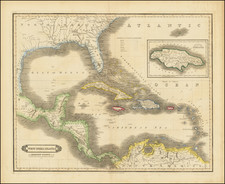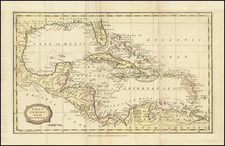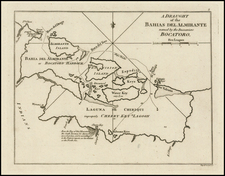A fine 17th Century map of Bermuda, by John Ogilby, one of the leading figures in English Restoration cartography.
This beautifully-composed and detailed map shows Bermuda divided into the domains of the various 'tribes', the names given to the various private proprietors of the island, who originally received royal patents from King James I in the early 17th Century. The island's capital, St. George's, is located in the far right of the map, and various forts, parish churches and roads are labelled throughout the chart. The placement of crosses in the coastal waters identifiy the dangerous reefs which surround Bermuda. A finely engraved title cartouche features putti and maritime creatures.
Bermuda was first settled in 1609, when Sir George Sommers and a party of colonists arrived aboard the Sea Venture, on an expedition sponsored by the Virginia Company. Richard Norwood was commissioned to carry out the first survey of the islands in 1616. His meticulous and exceedingly accurate chain survey had the distinction of being the first survey of any English colony. Amazingly, at the age of 72, Norwood re-surveyed Bemuda in 1662. The present map is based on Norwood's surveys, as are all other important 17th Century maps, including those by John Speed (1627), Willem Blaeu (1630), and the sea chart by Arent Roggeveen (1675).
John Ogilby (1600-76) was the "Cosmographer and Geographic Printer" to Charles II, and one of the leading lights of the great flourishing of English cartography that occured during the Restoration Era. This map is from Ogilby's Ameirca (London, 1671) a commerically-successful description of the Americas, which featured many fine folio maps.
John Ogilby (1600-1676) was an English geographer and publisher, one of the most prominent of the seventeenth century. Little is known of his early life but by 1619 he was apprenticed to John Draper, a dancing-master in London. He worked as a dancing-master, courtier, and theater owner form 1620-1641. From 1649 he worked as a poet, translator, and publisher of classical texts. It is only in the last decade of his life that he entered into geography.
In 1649, Ogilby published his first translation, of Virgil, and continued to put out translations in the 1650s and 1660s. In March 1661 he was reconfirmed as master of revels in Ireland and appointed master of the king’s imprimeries, or king’s printer. From 1662 to 1665 he was in Ireland, where he most likely met Robert Boyle. He returned to London only to lose much of his printing stock in the Great Fire of 1666. Post-fire, he became assistant surveyor to the city, where he met Robert Hooke and Christopher Wren.
In 1669, Ogilby published Embassy to China. At the same time, he planned to release atlases that would cover the entire world. These atlases would be funded via subscriptions, advertisements, and lotteries—all common practice at the time, especially for expensive multi-volume works. He released Africa and Atlas Japannensis in 1670, America in 1671 and Atlas Chinensis in 1671, and Asia in 1673. Ogilby compiled the works based on materials produced by others and they reflect a growing interest in the wider world within England.
In 1671, while producing the atlases, Ogilby secured another royal title, that of his Majesty’s cosmographer. He used this title when publishing Britannia in 1675, his best-known work. The Britannia is best described as a road atlas; it shows 2519 miles of road in 100 strip maps. This technique would be widely adopted in the subsequent century. His method of measuring with a waywiser, a large wheel, also helped to standardize the distance of the English mile at 1760 yards. The Britannia was a major achievement in early English cartography and was republished in 1698, 1719, and 1720.










![Culiacanae, Americae Regionis, Descriptio [with] Hispaniolae, Cubae, Aliarumqe Insualrum Circumiacientium Delineatio](https://storage.googleapis.com/raremaps/img/small/86114.jpg)
![[Hand Drawn Map] Le Golfe de Mexique avec les Pays Circonvoisins](https://storage.googleapis.com/raremaps/img/small/91580.jpg)

![Map of Mexico, Central America, and the West Indies [Insets of Bermuda, Cuba, Jamaica and Panama Railroad]](https://storage.googleapis.com/raremaps/img/small/70686.jpg)
